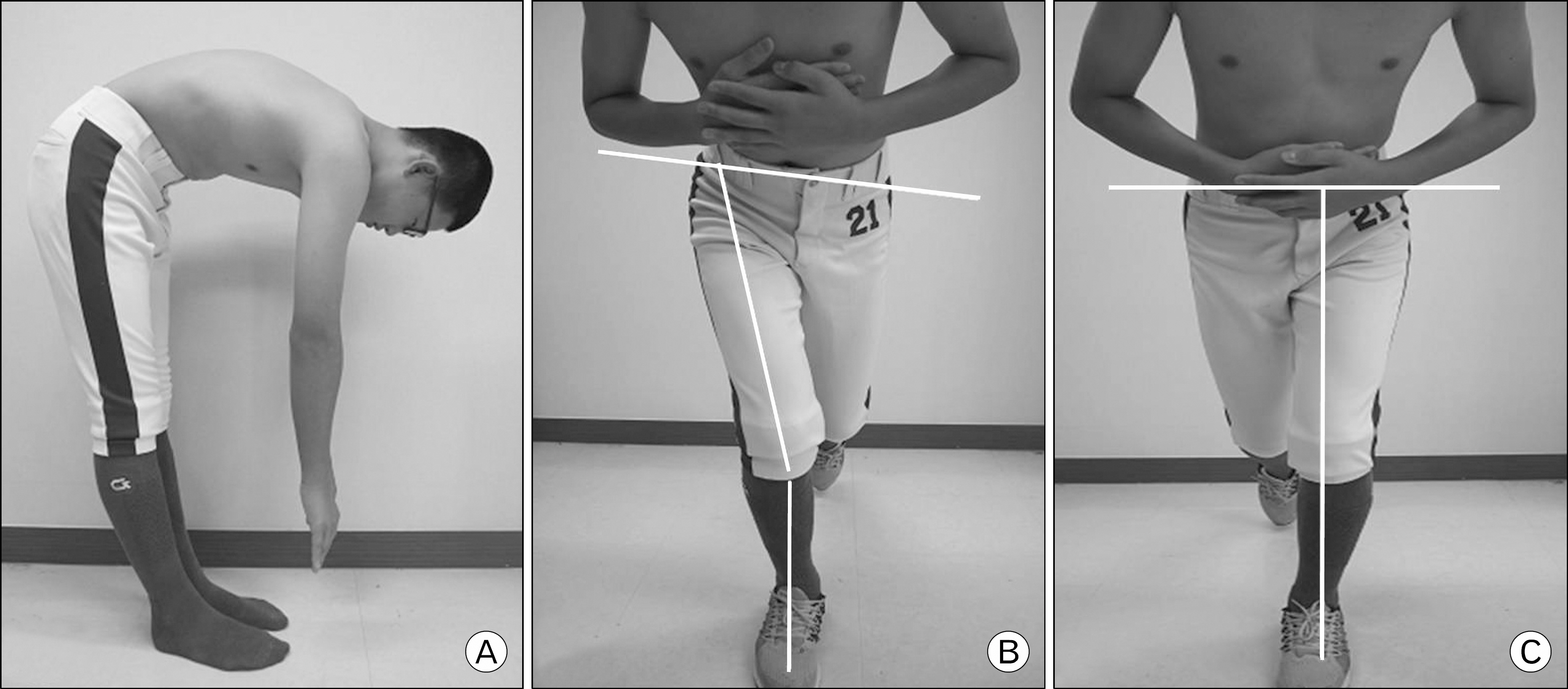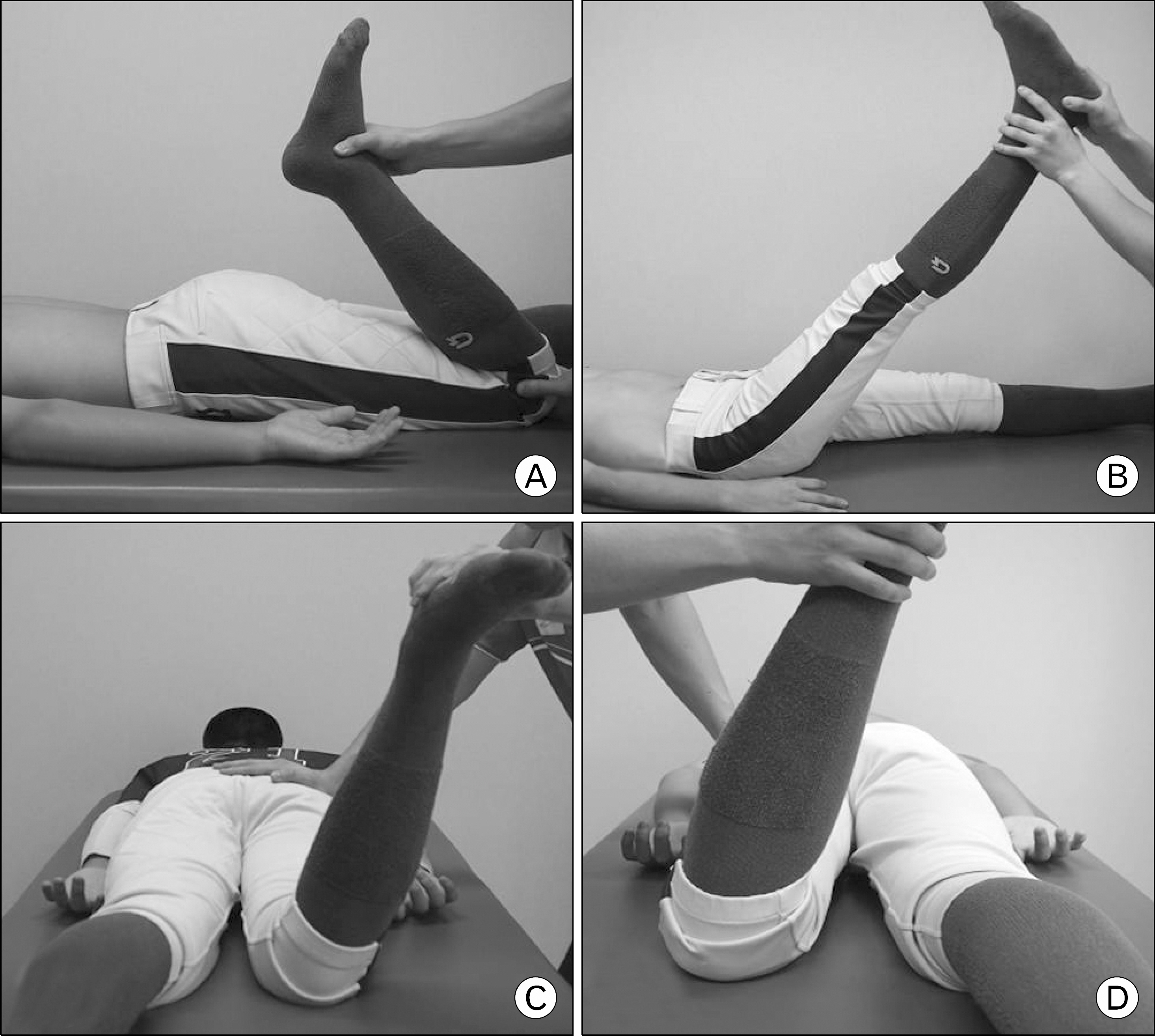Korean J Sports Med.
2014 Dec;32(2):112-119. 10.5763/kjsm.2014.32.2.112.
Evaluation of the Kinetic Chain in Little League Elbow
- Affiliations
-
- 1Department of Orthopaedic Surgery, Good Samsun Hospital, Busan, Korea. spinehth@gmail.com
- KMID: 2288667
- DOI: http://doi.org/10.5763/kjsm.2014.32.2.112
Abstract
- This study is to evaluate the abnormalities in the kinetic chain in the players with little league elbow during the medical screening of middle school baseball teams. Ninety-three players were examined with elbow ultrasonography in the field. Using kinetic chain evaluation test, 27 players sonogrphically diagnosed of little league elbow in dominant arm were compared with 25 players who were normal as control. Scapular-spine distance, horizontal flexion test, combined abduction test, and glenohumeral internal rotation deficit were used for evaluating kinetic chain in the upper extremities, while tightness of quadriceps and hamstring muscles, internal rotation of stance leg, and external rotation of stride leg were used for lower extremities. Also, the single leg stance test and finger-floor distance were used for core stability and flexibility. Twenty-five of 27 players (93%) having little league elbow showed kinetic chain abnormalities of either upper or lower extremities or trunk. This rate was significantly higher for the players having the little leaguer's elbow than control (28%) (p=0.017). Each specific tests for evaluating kinetic chain were also more prevalent in little league elbow group than control, and the abnormalities in the upper extremity were more common than those in lower extremity (p=0.026). Combined abduction test (23/27) and limitation of internal rotation of stance leg (16/27) were the most prevalent abnormalities in upper and lower extremity test, respectively. Our findings showed that there are many abnormalities in kinetic chain in players having the little league elbow and it may be associated with pathogenesis of little league elbow.
MeSH Terms
Figure
Reference
-
1. Pappas AM. Elbow problems associated with baseball during childhood and adolescence. Clin Orthop Relat Res. 1982; 164:30–41.
Article2. Brogdon BG, Crow NE. Little leaguer's elbow. Am J Roentgenol Radium Ther Nucl Med. 1960; 83:671–5.3. Fleisig GS, Barrentine SW, Zheng N, Escamilla RF, Andrews JR. Kinematic and kinetic comparison of baseball pitching among various levels of development. J Biomech. 1999; 32:1371–5.
Article4. Keeley DW, Hackett T, Keirns M, Sabick MB, Torry MR. A biomechanical analysis of youth pitching mechanics. J Pediatr Orthop. 2008; 28:452–9.
Article5. Feltner ME DJ. Three dimensional interactions in a two segment kinetic chain. Part I: general model. Int J Sport Biomech. 1989; 5:403–19.6. Putnam CA. Sequential motions of body segments in striking and throwing skills: descriptions and explanations. J Biomech. 1993; 26(Suppl 1):125–35.
Article7. Huang YH, Wu TY, Learman KE, Tsai YS. A comparison of throwing kinematics between youth baseball players with and without a history of medial elbow pain. Chin J Physiol. 2010; 53:160–6.8. Kibler WB. The role of the scapula in athletic shoulder function. Am J Sports Med. 1998; 26:325–37.
Article9. Pappas AM, Zawacki RM, McCarthy CF. Rehabilitation of the pitching shoulder. Am J Sports Med. 1985; 13:223–35.
Article10. Burkhart SS, Morgan CD, Kibler WB. The disabled throwing shoulder: spectrum of pathology Part I: pathoanatomy and biomechanics. Arthroscopy. 2003; 19:404–20.
Article11. Crossley KM, Zhang WJ, Schache AG, Bryant A, Cowan SM. Performance on the single-leg squat task indicates hip abductor muscle function. Am J Sports Med. 2011; 39:866–73.
Article12. Tsuchiya A, Yoshida M, Oyabu N, et al. Medical screening for baseball players in little league by Hara's test and flexibility of lower extremities. Shoulder Joint. 2010; 34:523–6.13. Gugenheim JJ Jr, Stanley RF, Woods GW, Tullos HS. Little League survey: the Houston study. Am J Sports Med. 1976; 4:189–200.
Article14. Lyman S, Fleisig GS, Waterbor JW, et al. Longitudinal study of elbow and shoulder pain in youth baseball pitchers. Med Sci Sports Exerc. 2001; 33:1803–10.
Article15. Klingele KE, Kocher MS. Little league elbow: valgus overload injury in the paediatric athlete. Sports Med. 2002; 32:1005–15.16. Olsen SJ 2nd, Fleisig GS, Dun S, Loftice J, Andrews JR. Risk factors for shoulder and elbow injuries in adolescent baseball pitchers. Am J Sports Med. 2006; 34:905–12.
Article17. Hang DW, Chao CM, Hang YS. A clinical and roentgenographic study of Little League elbow. Am J Sports Med. 2004; 32:79–84.
Article18. Pappas AM, Zawacki RM, Sullivan TJ. Biomechanics of baseball pitching. A preliminary report. Am J Sports Med. 1985; 13:216–22.19. Sabick MB, Torry MR, Lawton RL, Hawkins RJ. Valgus torque in youth baseball pitchers: a biomechanical study. J Shoulder Elbow Surg. 2004; 13:349–55.
Article20. Kibler WB, Chandler J. Baseball and tennis. Griffin LY, editor. editor.Rehabilitation of the injured knee. St. Louis: Mosby;1995. p. 219–26.21. Beckett M, Hannon M, Ropiak C, Gerona C, Mohr K, Limpisvasti O. Clinical assessment of scapula and hip joint function in preadolescent and adolescent baseball players. Am J Sports Med. 2014; 42:2502–9.
Article22. Wight J, Richards J, Hall S. Influence of pelvis rotation styles on baseball pitching mechanics. Sports Biomech. 2004; 3:67–83.23. Tippett SR. Lower extremity strength and active range of motion in college baseball pitchers: a comparison between stance leg and kick leg. J Orthop Sports Phys Ther. 1986; 8:10–4.
Article24. McCulloch PC, Patel JK, Ramkumar PN, Noble PC, Lintner DM. asymmetric hip rotation in professional baseball pitchers. Orthop J Sports Med. 2014; 2:http://dx.doi.org/10.1177/2325967114521575.
Article
- Full Text Links
- Actions
-
Cited
- CITED
-
- Close
- Share
- Similar articles
-
- Scapular Dyskinesis
- Comparisons of Accuracy of Knee Joint Motion During Closed verse Open Kinetic Chain Tasks in Subjects with Flexible Flatfeet
- Preseason Assessment for Throwing Shoulders in Korean Professional Baseball League Pitchers and Factors Affecting Kerlan-Jobe Orthopaedic Shoulder and Elbow Scores
- Comparison of the Normal Visual Fields Between the Goldmann and Humphrey Kinetic Perimetries
- Comparative Analysis of the Humphrey Static Perimetry and the Goldmann Kinetic Perimetry: Application of the Humphrey Static Perimetry to Visual Disability Evaluation





